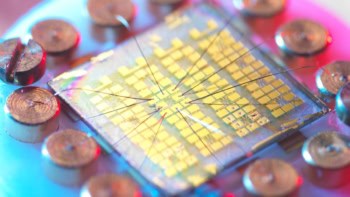Two independent groups in the US have created “buses” for transferring information between two microchip-based qubits. The buses could allow a number of qubits to be joined together to make powerful quantum computers using standard chip manufacturing processes.
The basic unit of information in a quantum computer is the qubit, which can take the value 0, 1 or — unlike a classical bit — a superposition of 0 and 1 together. When many of these qubits are combined or “entangled” together a quantum computer can process them simultaneously, enabling it to work exponentially faster than its classical counterpart for certain operations.
To achieve this entangling feat, quantum computers need to link remote qubits via a bus that can transmit their states to and fro. Although buses have already been created for trapped ions and atoms — two of the many realizations of qubits — a bus for a superconducting qubit had yet to be realized. Superconducting qubits are particularly promising for practical quantum computers because the whole system can potentially be printed onto a circuit in a similar way to those in present-day computers.
Raymond Simmonds and colleagues from the National Institute of Standards and Technology (NIST) have fabricated two superconducting “phase” qubits — each a super-cooled insulating barrier sandwiched by a pair of tiny metal grains — separated by a bus in the form of a cavity that contains a standing wave. They first prepare one of the qubits in the desired 0, 1 or superposition state with a microwave pulse that changes the quantum oscillations of the phase difference between the barrier’s electrodes. The researchers then use an external field to briefly tune the energy difference across the barrier so that the qubit resonates with the cavity and transfers its state to the standing wave, where it can be stored for up to 10 ns. At the other end of the cavity, the same tuning process transfers the state to the other qubit (Nature 449 438).
Meanwhile, Robert Schoelkopf and colleagues from Yale University used microwaves to prepare superconducting “charge” qubits, which are physically similar to phase qubits but have states defined by the number of paired-up electrons that have tunnelled across the barrier. Their cavity has no initial standing wave, instead relying on the electron-pair tunnelling itself to emit a virtual photon into the cavity and create a combined superposition state between the qubits. This is a similar technique to work performed by the Yale group last week, in which they showed that a superconducting qubit could be used as a single photon source (Nature 449 443).
The three operations — information transfer, storage and combined superposition — by the NIST and Yale groups could eventually underlie the gate operations required to perform calculations in a microchip-based quantum computer. However, this will require many superconducting qubits to be linked together, and in a much more reliable way than the current devices.



